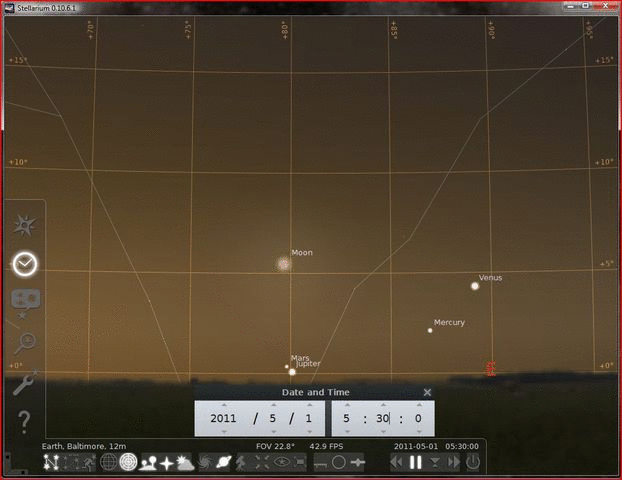
|
|
Morning Dance of the Planets During May, 2011 (Animation by Curt Roelle). Simulation software by Stellarium. Online animation service provided by MyspaceGens. |
This month four bright planets are putting on an "air show" low in the morning sky. An unobstructed horizon with clear skies, and maybe a pair of binoculars, is all you need to see some close encounters of the celestial kind.
Astronomer Fred Schaef calls it "Drama at Dawn" with "the most compact visible gathering of four bright planets in decades." Guy Ottewell is even more enthusiastic, calling it "one of the tightest four planet gatherings of a lifetime – and much more."
"Combined all together in one month and small area of the sky," Ottewell says, "they offer an astonishingly rich and complex show." If you're prepared to watch, knowing where and when to look, and what to expect, this rare dance performance starring Mercury, Venus, Mars, and Jupiter should be easy to watch over a period of two or three weeks.
But let's start with the bad news first. The spectacle takes place in the morning sky when fewer people are likely to be up, let alone outside, as they would be for a similar evening performance. Second, the planets are situated very low in the sky during bright morning twilight. With each passing minute the planets rise higher, but the sky also brightens making them more difficult to view. However, with preparation morning observers will be rewarded. With these caveats having been said, let's discuss what happens and when.
Each clear day you should begin watching about 30-45 minutes before sunrise. The sun rises earlier each day, so you need to get up a minute or two earlier each day to stay ahead of it.
On May 1 Mars and Jupiter pass each other by an amount less than a moon's width, but might be too low to see. If you can locate the moon very low in the east, look for them directly beneath it between 05:30 and 05:45 a.m. EDT. With binoculars, find the moon and focus. Then move them slowly downward toward the horizon until you see Jupiter with fainter Mars just to its upper left. Brilliant Venus is visible as well, to moon's right side. They appear star-like in binoculars.
Over the next several days, the angular distance between Mars and Jupiter increases. Mars inches left (north) along the horizon and Jupiter moves right (south). Meantime Venus passes Mercury as both drift left along the horizon with Jupiter moving upward to meet them. Best time to look is probably between 05:20 and 05:40 a.m.
The main show begins on May 9, with Jupiter, Venus, and Mercury forming a close slowly changing trio lasting for four days. Venus is the brightest and highest of the bunch, drifting through the sky from day to day along with Mercury, to its lower left. Jupiter rapidly approaches the pair from the lower left. On May 10 Jupiter and Venus are side by side with Venus being the brighter "star" on the right.
By May 12 Jupiter is to the upper right of Venus and Mercury and pulling away. But the show hasn't ended yet. It's only half time.
Lagging behind Jupiter, Mars now has its own counter with the Venus-Mercury pair. Mercury caches up with Venus again on May 10 and passes beneath it. Faint Mars is directly to Venus's left. The three form an almost isosceles right triangle.
By next day Mercury has again pulled ahead of Venus. By the morning of the 24th Venus catches up to Mars, which is directly above it. The following day Mars have moved to the upper right of Venust. From then on the three planets move apart, as they continue drifting northward along the morning horizon.
They say that a picture is worth a thousand words. This is why I have created an animation simulating the dance of the four planets from May 1 through 26. The video is on the Star Points web site at http://www.starpoints.org/2011/sp201105.html. Scroll down the page to the "Morning Dance."

|
|
Morning Dance of the Planets During May, 2011 (Animation by Curt Roelle). Simulation software by Stellarium. Online animation service provided by MyspaceGens. |
The software used to simulate the planets is called Stellarium. It was brought to my attention by Brian Eney, a member of the Westminster Astronomical Society and the planetarium director at Bear Branch Nature Center. I highly recommend that readers download it from http://www.stellarium.org and try it out. There are versions available for Windows, Macintosh, and Linux operating systems. Enjoy this month's dance of the planets. Use this opportunity to view Earth's four closest planetary neighbors with your own eyes.